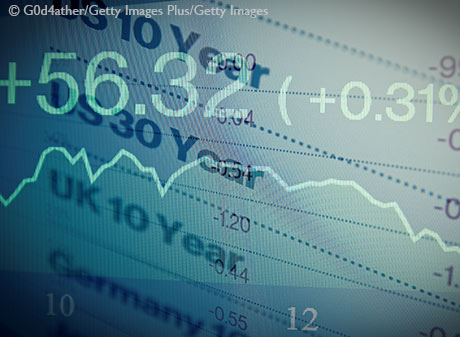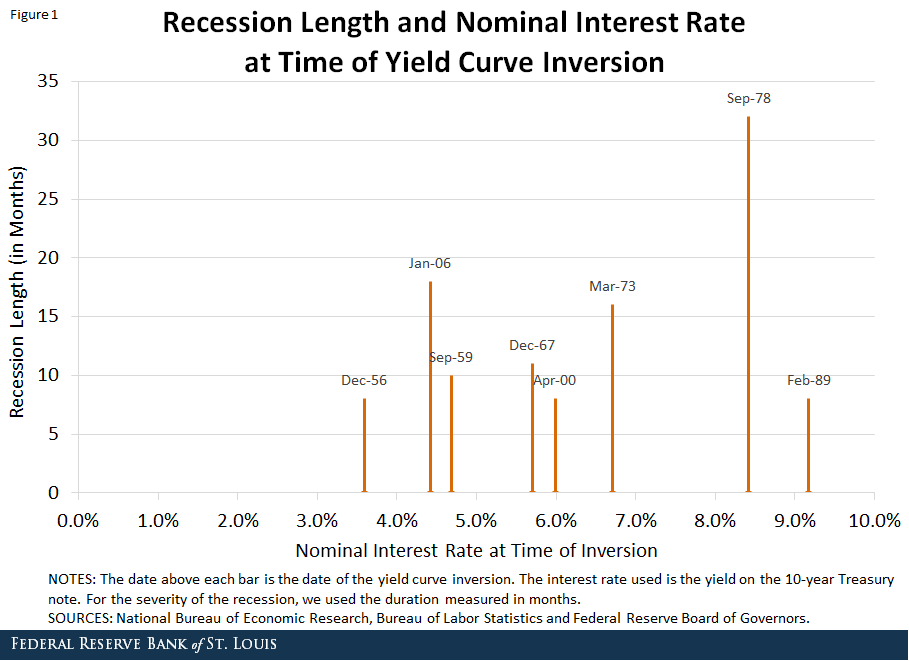What Real Interest Rates Tell about the Recession to Follow

Can economists say anything about the severity of a recession before it starts? This blog post argues that long-term real interest rate levels before recessions exhibit a correlation with the severity of the recession, measured in terms of its duration or its impact on macroeconomic variables such as the unemployment rate. This topic is especially pertinent as one yield curve briefly inverted and prominent Federal Reserve officials have discussed the importance of the yield curve when making policy decisions.
Real Interest Rates and Yield Curve Inversions
To analyze interest rates before a recession, we looked at real interest rates when the yield curve inverted before a recession. A previous post on The FRED Blog, “The data behind the fear of yield curve inversions,” outlined the significance and reliability of yield curve inversions to predict recessions.
With the yield curve inverting many months ahead of a recession, using the level of the real interest rate at the time of the inversion provides an unbiased measure as the traditional response of monetary policy to counteract recessionary trends is unlikely to have occurred.The interest rate used in this analysis is the yield on the 10-year Treasury note. To convert this rate to real terms, we used inflation expectations from the Survey of Professional Forecasters as the expected inflation rate. As these data goes back to 1970, we used the average annual inflation rate calculated from the consumer price index (CPI) for periods before 1970. The nominal interest rates are the nominal yields on the 10-year Treasury note. For the severity of the recession, we used the duration (measured in months) and the change in total unemployment (measured as the change in the unemployment rate from the start of the recession to the maximum level that occurred during that recession).
Reading the Analysis
Figures 1 and 3 plot the length of the recession according to the National Bureau of Economic Research (NBER) and the interest rate at the time of the yield curve inversion. Figures 2 and 4 plot the change in the unemployment rate and the interest rate at the time of inversion. The date above each bar is the date of the yield curve inversion. Figures 1 and 2 plot nominal interest rates, and Figures 3 and 4 plot real interest rates using the methodology described above. It should be noted that we combined the 1980 and 1981 recessions. While the NBER distinguishes between the two recessions, there was only a 12-month recovery between the recessions, and real consumption and unemployment never returned to pre-1980 levels during the recovery. Therefore, we combined the recessions and recovery into one episode.
Real Interest Rates and Recession Severity
Plotting nominal interest rates and lengths of recessions or unemployment changes (again, Figures 1 and 2) did not yield any insight into a relationship between interest rates and recession severity. However, a very clear negative correlation between real interest rates and the severity of the recession appears in Figures 3 and 4. In general, the plot suggests that the lower the level of the real interest rate, the longer or deeper the recession that follows a yield curve inversion.
These empirical results are provocative and suggest there may be a causal relationship between levels of real interest rates and economic output. Our preferred view is that low levels of real interest rates capture early warnings of future slowdown in economic growth. Furthermore, this view suggests that the lower the level of the real rate, the higher the likelihood that the economy will enter a recession. According to this view, future slow growth causes a decline in long-term real interest rates, and not the other way around. But, we leave this issue for a future post.




Notes and References
1 A previous post on The FRED Blog, “The data behind the fear of yield curve inversions,” outlined the significance and reliability of yield curve inversions to predict recessions.
2 It should be noted that we combined the 1980 and 1981 recessions. While the NBER distinguishes between the two recessions, there was only a 12-month recovery between the recessions, and real consumption and unemployment never returned to pre-1980 levels during the recovery. Therefore, we combined the recessions and recovery into one episode.
Additional Resources
- On the Economy: Is the U.S. Economic Expansion Due to End?
- On the Economy: Predicting Recessions: Which Signals Are More Accurate?
- On the Economy: Housing Indicators to Watch in 2019
Citation
Carlos Garriga and Matthew Famiglietti, ldquoWhat Real Interest Rates Tell about the Recession to Follow,rdquo St. Louis Fed On the Economy, April 4, 2019.
This blog offers commentary, analysis and data from our economists and experts. Views expressed are not necessarily those of the St. Louis Fed or Federal Reserve System.
Email Us
All other blog-related questions



